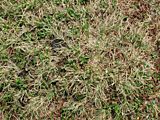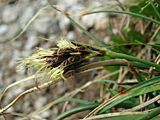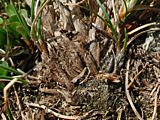Born at the time of Jesus: the extremely slow-growing sedge Carex curvula
In the Alps large areas over siliceous substrate above 2300 m and up to 2800 m are covered by natural grassland dominated by a slow growing rhizomatous sedge Carex curvula. This species is forming dense tussocks and produces a closed sward.
Although fertile tillers of C. curvula are regularly present, successful seedlings are rare. Seedling establishment is prevented by the harsh environmental conditions, by the short growing season, and by the densely rooted raw humus of the inter-tussock space.
Vegetative spread of C. curvula is less than 1 mm a year, regulated by ramet density such that no intra-clonal competition does occur. The density is usually below 3000 ramets per square meter.
In a molecular study with regularly sampled shoots from an area of 2.0 x 0.4 m a total of 15 different intermingled genotypes were found illustrating that sexual reproduction is not completely nil. The biggest clone formed a relatively homogeneous patch with more than 7000 tillers and a diameter of at least 1.2 m. It was estimated that this clone had an age of around 2000 years.
This high age illustrates that clones of alpine species may persist on a single spot over long periods supporting changes in climate as the warming period during the Middle Ages or the "little ice age" in the 19th century.





